29 Best Things To Do In (And Near) Badlands National Park
While Badlands National Park isn’t huge, this park packs a lot of attractions inside its borders. This article will cover the best things to do in Badlands National Park and also list some attractions near the park so you don’t miss a thing on your visit!

We visited this park during a road trip from Washington to Minnesota and were surprised by the beauty of the Badlands and how much there was to do here. Our one day trip quickly turned into a two day itinerary. Thankfully we weren’t on a schedule and had time to explore the park a little more in depth, although we could have easily spent more time here.
This is the perfect park to visit for road trippers as it is easily explored by car along a scenic drive that will take you from end of the park to the other, through the most unreal scenery.
Although this is a national park that can be covered within one day, you’ll see from the list of things to do below that dedicating two days in Badlands National Park will allow you to truly soak in the magic.
Badlands National Park At A Glance
Before diving into the best things to do in Badlands National Park, here are a few things to know to help you plan your trip.
Best Time To Visit: Summer is the best time to visit Badlands National Park when the weather is warm and there is less likelihood of windy or snowy weather.
Where To Stay: If you’re looking to stay inside the park, you can stay at Cedar Pass Lodge, the only accommodations in the park. Outside of the park, the best hotel is the Best Western Plains Motel in Wall.
How To Get There: If you are flying into South Dakota to visit Badlands National Park, the closest airport is Rapid City Regional Airport (RAP) in Rapid City. In Rapid City you can search for car rentals using rentalcars.com or rent an RV or campervan using Outdoorsy and RV Share to get to the park.
Badlands National Park, established in 1978, protects 244,000 acres of striking rock formations and expansive mixed-grass prairie lands, the largest expanse of protected prairie in the national park system.
Before getting to this list of things to do in Badlands National Park, let’s go over the park’s uninviting name. The term badlands is a geologic term that defines landscapes that are typically characterized by soft sedimentary rocks that erode easily. You may have seen terrain that looks like Badlands National Park before in other states, or even other countries. For example, Theodore Roosevelt National Park in North Dakota also has badlands.
Badlands are formed by deposition and erosion. Deposition is the process of rocks gradually building up over millions of year caused by different earth processes like rivers and wind. Erosion is the process of the rocks gradually eroding away which is what is happening in Badlands National Park right now.
It is estimated that the Badlands are eroding at the rate of one inch per year, which is a rapid rate for rocks. In contrast, the granite of the Black Hills just to the west of Badlands National Park, erodes at the rate of one inch per 10,000 years.
Scientists estimate that in the next 500,000 years, the Badlands will have eroded completely! If there is one constant on this earth, it is change. Whether it is the climate, species, or landscapes, nothing ever stays the same.
Best Things To Do In Badlands National Park
Hikes In Badlands National Park
Unlike other national parks, Badlands is not known for epic hiking trails. The majority of hiking trails in Badlands National Park are very short and easy, and nearly all of them are under two miles roundtrip.
Hiking in Badlands is a great way to see the park’s dramatic and colorful rock formations from a different perspective so be sure to make time on your itinerary for at least one or two hikes on your visit. Here are the top three hikes in Badlands you shouldn’t miss.
Hike The Window Trail

At 0.25 miles roundtrip, the Window Trail is the shortest and easiest hike in Badlands National Park. This hiking trail runs along a boardwalk and ends at the “Window”, a natural opening in the Badlands Wall that overlooks an eroded canyon.
Stroll The Fossil Exhibit Boardwalk

The Fossil Exhibit Trail is another very short and easy hike. This hiking trail (if you can call it that) runs for 0.25 miles along a boardwalk through rock formations that contain millions of years of earth’s history and one of the most concentrated mammal fossil beds in the world.
Along the trail are several information boards that explain the geologic history of this area and some of the animals that once roamed the Badlands of South Dakota.
If you don’t have time to stop in at Badland’s Visitor Center to learn about fossils found in the area, this is a great spot to stop and get a quick overview on the park’s natural history.
Hike The Notch Trail

The Notch Trail is the best and most popular hiking trail in Badlands National Park! If you only have time for one hike in Badlands, this should be it!
This hike begins with a short stroll through a scenic canyon full of strange rocky formations that include towering buttes and spires. Eventually you’ll come to a fifty-foot tall wooden ladder that once climbed, will take you along a steep cliff ledge to the trail’s final viewpoint which overlooks the White River Valley.
Trust me when I say this hike is a lot of fun! Kids will especially enjoy walking through the maze of interesting rock formations and scrambling up rocks and ladders to reach the final destination.
Travel Tip: Because the viewpoint at the end of the Notch Trail faces west, it is a great place to watch sunset in Badlands National Park from an elevated location.
>>Read: How To Hike The Notch Trail At Sunset
Road Trips In Badlands National Park
There are two scenic drives that you can complete while visiting Badlands National Park; The Badlands Loop Road and Sage Creek Rim Road. Driving the Badlands Loop Road is the most popular thing to do in Badlands National Park so if you only have time to do one thing during your visit, this should be at the top of your list!
Drive Badlands Loop Road

The Badlands Loop Road is the main road through the park and driving its entire length is the best way to get to know this surreal landscape. You can begin the 39 mile road trip from the park’s northwest entrance or the northeast entrance depending on which direction you are coming from.
You’ll be mesmerized by incredible vistas seen along the entire length of this drive that will take you from one scenic overlook to another. The overlooks provide unbelievably stunning views of the Badlands otherworldly terrain.
There are twelve overlooks where you can see brightly colored mounds, towering spires, and canyons filled with hoodoos. Some of the overlooks have information boards and some provide access to hiking trails and boardwalks through the strange environment.

If you are on a tight schedule, you can take this scenic drive and see most of the park’s highlights in one to two hours. I highly recommend taking a few minutes to get out of the car at some of the overlooks to truly appreciate how unique and wonderful this landscape is.
Although this drive can be completed in under two hours without stopping, you’ll more than likely want to pull over every chance you get so be sure to allow at least three hours if you want to be able to soak in the scenery without feeling rushed.
Badlands Loop Road, which is also known as State Route 240, is in fact not a loop road at all. Once you have driven the scenic drive from one end to the other, you will either need to drive back along the same road or hop on Interstate-90 to complete the loop.
Drive Sage Creek Rim Road
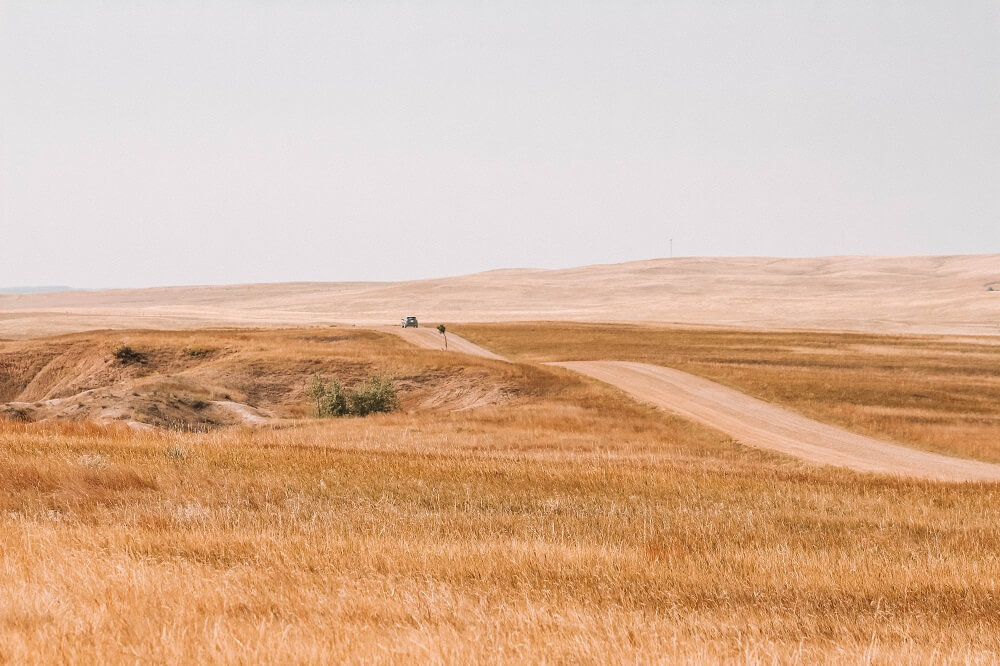
Sage Creek Rim Road is a gravel road that begins where Badlands Loop Road ends. The scenery along this stretch of road is nothing like the landscape seen along Badlands Loop Road. Instead of red-striped spires, yellow mounds, and other weird rock formations, Sage Creek Rim Road features rolling green hills and vast grassy plains. This is why all the grazing animals prefer to be on this side of the park.
Wildlife you are likely to see along Sage Creek Rim Road include bison, bighorn sheep, pronghorn antelope, and prairie dogs.
The Roberts Prairie Dog Town can be found along this road so expect to see prairie dogs everywhere! They are incredibly entertaining to watch and if nobody else is around but you, and you are quiet and move slowly, they will likely go about their day foraging for food and chirping to each other. If there are too many people making loud noises, the prairie dogs are likely to hide in their burrows until they feel safe again.
There are three overlooks along this road that shouldn’t be missed; the Hay Butte Overlook, Wilderness Overlook, and the Sage Creek Basin Overlook. Be sure to get out of the car to see the views and don’t forget your camera!
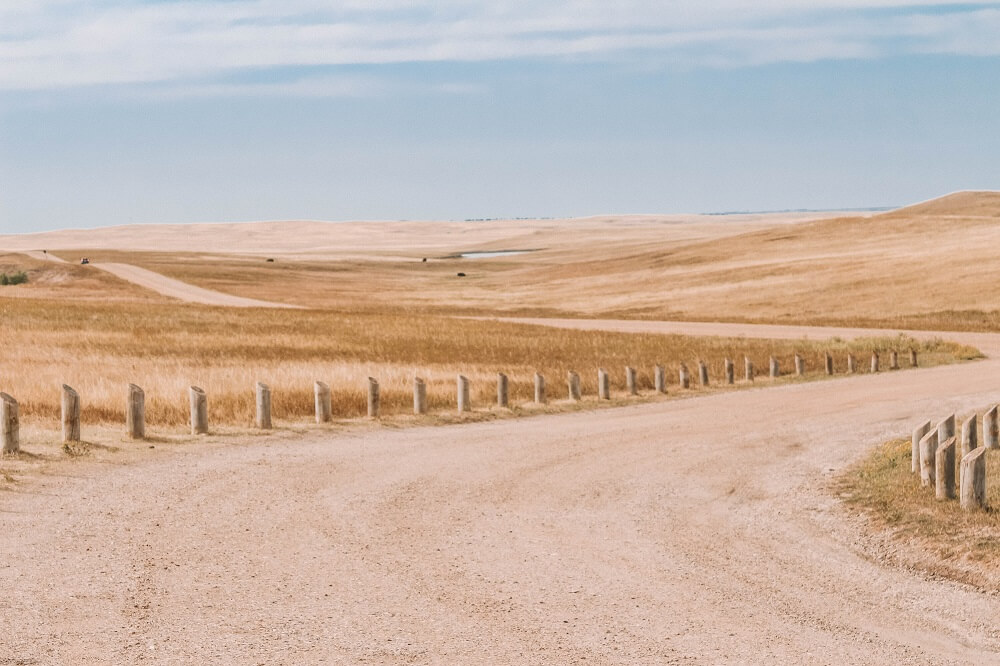
Because Sage Creek Rim Road is close to the Pinnacles Entrance (northwest entrance), you might want to visit the Sage Creek area first before driving through the rest of the park if you are entering from this location.
Remember that Sage Creek Rim Road is a bumpy gravel road so take it slow as you drive through this part of the park. The first portion of the road passes over alkali flats then rises up into ranch country. After about ten miles you will be near the northwest edge of the Badlands. The drive ends at State Route 44 near the small town of Scenic (which by the way is not scenic at all).
Is the drive along Sage Creek Rim Road unmissable? In my opinion yes! It’s less trafficked and just an overall peaceful and scenic drive and the best place to see wildlife in Badlands National Park.
See Wildlife In Badlands National Park
If you’re a wildlife enthusiast, you’re going to love Badlands National Park! This national park is terrific for wildlife viewing and unlike other national parks, you don’t have to hit the hiking trails to spot animals. In fact, you won’t even have to leave your vehicle to see wildlife in Badlands National Park.
Early morning or late afternoon is usually the best time to see wildlife, however in Badlands, it seemed as though wildlife was abundant throughout the park during all times of the day. Here are some of the park’s residents you should keep an eye out for.
Roberts Prairie Dog Town

There’s no doubt prairie dogs are one of the highlights at Badlands National Park. These oh so adorable rodents live in groups called Prairie Dog Towns and Badlands is home to the most famous prairie dog town in the United States – the Roberts Prairie Dog Town!
You can watch the cute critters go about their day hopping from burrow to burrow, digging for plants to eat, and calling out to each other.
We found the prairie dogs to be rather inquisitive animals, and even had a few of them come very close to us while we were sitting on the ground observing them. Since we were the only people there at the time, I suppose they felt comfortable and safe but anytime other people would pull up and make a lot of noise they would disappear back into their burrows.
Roberts Prairie Dog Town is located on Sage Creek Rim Road. There is a large parking lot so you can pull over and get out of your vehicle. As with most wildlife, you are more likely to see the prairie dogs here if you are quiet and make non-threatening movements. Talking loudly and moving quickly usually scares most animals in the wild.
Besides Roberts Prairie Dog Town, other places you can see prairie dogs in Badlands National Park include the Burns Basin Overlook and Sage Creek Campground.
Find Bighorn Sheep

One of the best places in the United States to have a close encounter with wild Bighorn Sheep is in Badlands National Park! Bighorn Sheep usually inhabit high alpine meadows, mountain slopes, and rocky cliffs, but here in Badlands National Park they roam the vast grassy plains.
This means that you don’t need to trek into high country to spot your first Bighorn sheep! In fact, you won’t even need to get out of your vehicle to see these park residents.
We had our first encounter with Bighorn Sheep in the northwest section of the park as soon as we entered the Pinnacles Entrance. On the left side of the road heading into the park, we immediately spotted a small flock on top of a grassy hill that slowly started to descend. We stopped to get a few photos with a zoom lens before continuing with our drive.
Less than half a mile down the road, there were more sheep but this time they were right beside the road! We pulled up to stop and watch them nibble on the grass.
Since we live in eastern Washington and also do a lot of outdoor travel and recreation, this was not anywhere near the first time we had seen Bighorn, but it was the first time we had seen them at an arms length away. Well, I guess there were a few encounters that were too close for comfort on some of the hiking trails in Glacier National Park, but we were so worried about trying to maintain a safe distance that we really didn’t have time to look at them properly.
If you’ve never seen Bighorn Sheep before, take the opportunity to scout them out while you’re in the park because these creatures are usually very elusive.
Good places to find Bighorn in Badlands include along Sage Creek Rim Road, near Pinnacles Overlook, around the Cliff Shelf Hiking Trail, and along the Castle Trail.
Watch Bison Roam The Park
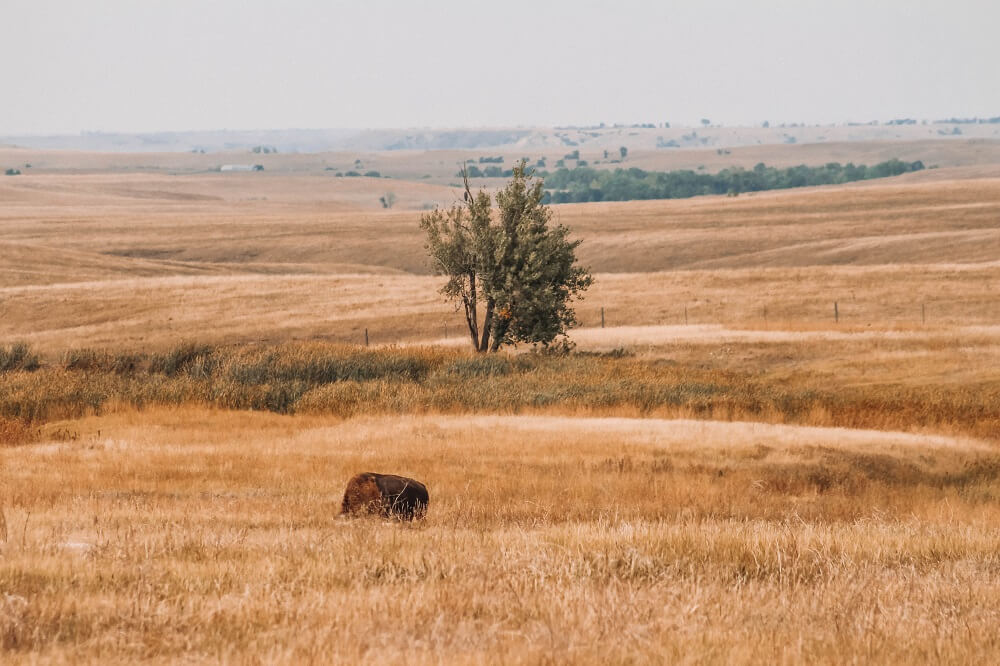
If you haven’t encountered bison before, you are going to love Badlands National Park because this national park has a healthy population of them! What’s even better about seeing these large land mammals in this park is that you won’t have to contend with hoards of tourists like at other parks to get an unobstructed view.
As far as wildlife watching goes, this national park allows intimacy and the time to stop and sit quietly whether in or out of your vehicle, and observe animals go about their daily routines.
The best place to find bison in Badlands is down Sage Creek Rim Road where you’ll more than likely see them roaming the grasslands. Take a drive down this partly maintained road and keep your eyes peeled!
Bison have long been synonymous with the American plains and were once sixty million strong. Sadly they were hunted almost to the point of extinction by Europeans starting in the 1800s. Throughout the 18th century, about 10,000 hunters poured into the Dakotas to collect bounties on then valuable bison hides — to the point where 5,000 were being killed a day. By 1884, bison had been reduced to an estimated 325 animals thanks to European settlement.

Fortunately, conservation programs have been able to bring back bison populations, although not back to the same numbers that once were.
In Badlands, bison were reintroduced in 1963, beginning with fifty bison from Theodore Roosevelt National Park. In the 1980s, twenty additional bison were brought in from Colorado National Monument. As of 2018, there are now more than a thousand bison thriving in Badlands National Park.
Other parks you can view bison include Yellowstone National Park, Theodore Roosevelt National Park, Custer State Park, the Bison Range in Montana, and Antelope Island in Utah.
Overlooks In Badlands National Park
While you’re driving through Badlands National Park you’ll come across twelve official overlooks where you can see brightly colored mounds, towering spires, and canyons filled with hoodoos. Be sure to allow enough time to be able to pull over and enjoy the stunning vistas. Here is a quick overview of the overlooks found in the park.
Sage Creek Basin Overlook
The Sage Creek Basin Overlook is located on Sage Creek Rim Road. The view from this point consists of vast grasslands with random yellow and red mounds that dot the landscape. Depending on the time of year, the grass will be lush and green or a wheat-colored yellow.
Badlands Wilderness Overlook
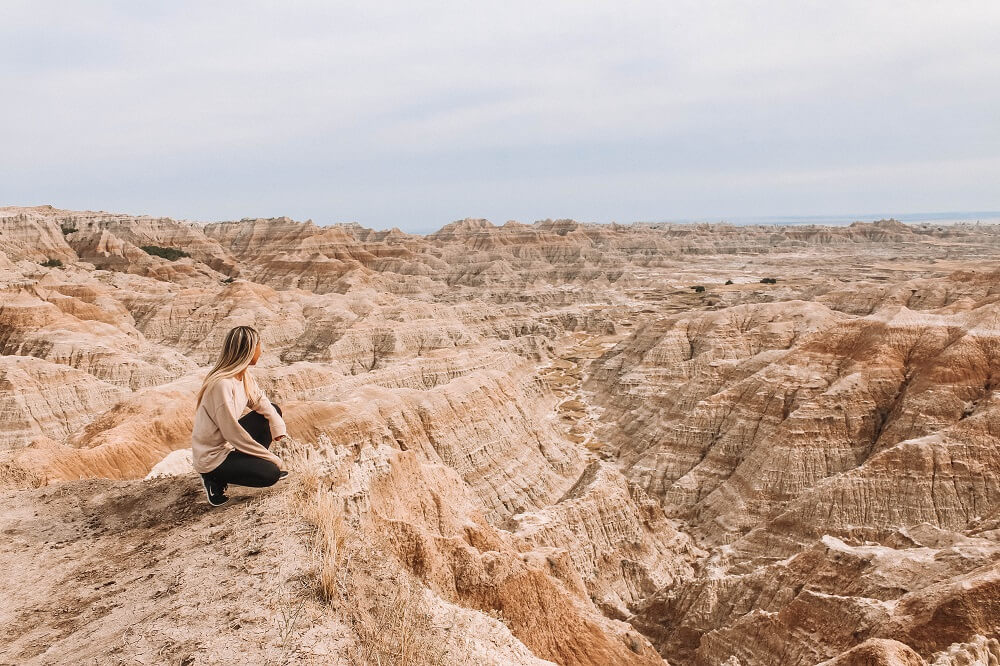
Badlands Wilderness Overlook is also located on Sage Creek Rim Road. This viewpoint is spectacular and consists of typical badlands terrain as far as the eye can see.
Hay Butte Overlook
The Hay Butte Overlook on Sage Creek Rim Road is remarkable and provides a good look at the seemingly endless badlands terrain. This was one of our favorite viewpoints in the park as the landscape here was incredibly colorful. It’s a great place to take photos so don’t forget your camera!
Pinnacles Overlook

This is one of the most popular overlooks in Badlands. The Pinnacles Overlook requires you to walk down a paved path to get to the breathtaking viewpoint of colorful mounds that can be seen for miles and miles. There is also a short trail along the canyon rim that will allow you to see the views from different perspectives.
Yellow Mounds Overlook

The Yellow Mounds Overlook is another popular overlook in the park but the views here are much different than the overlooks mentioned above. Here, the mounds and hillsides are painted a vivid mustard yellow color which are incredibly impressive to see.
The rocks here are known as Pierre Shale. After the Western Interior Seaway drained North into the Arctic Ocean, the leftover shales weathered into soils. Those soils are now preserved as the Yellow Mounds which are what geologists call a paleosol. Paleosols are ancient fossilized soils preserved in the rock record and they often appear as brightly colored layers like the Yellow Mounds, which gets its mustard color from a mineral called Goethite.
Homestead Overlook
The Homestead Overlook is like most of the other overlooks with views of eroding spires and mounds, however there is an interpretive sign here explaining the history of the homesteaders who poured into the Badlands when the Milwaukee Railroad was completed through the White River Valley in 1907.
Burns Basin Overlook
Burns Basin Overlook has beautiful views of rolling grassy hills and random rocky outcrops. These hills and rock formations contain sandstones, siltstones, mudstones, claystones, limestones, volcanic ash, and shale, that have been deposited over time from various sources such as ancient river beds.
The layers of the Badlands correspond with different moments in geologic time. They start with the oldest layer at the bottom, then move upwards in space and time towards the youngest layer which sits on top of the formations.
Prairie Wind Overlook

The Prairie Wind Overlook is unlike the other overlooks and instead of strange rock formations, what you’ll see here is a hauntingly beautiful vast swath of native grasslands. If you are interested in learning more about the prairie and grasses this is an overlook that you shouldn’t miss as there are several interpretive signs explaining the ecology and landscape of the park.
Panorama Point
You’ll walk along a short boardwalk to get to this overlook where you can see many jagged rock formations. If you’re lucky, you may even see Bighorn sheep roaming the area.
Bigfoot Pass Overlook
The Bigfoot Pass Overlook is named after Big Foot, the leader of the Miniconjou Sioux. Big Foot has the tragic distinction of being the leader of the group of Sioux who were gunned down by the Seventh Cavalry at Wounded Knee Creek in 1890.
Bigfoot Pass was a route used by Lakota leader Spotted Elk to evade the US Army. Approximately two hundred Hunkpapa Lakota fled to join Chief Spotted Elk (also known as Big Foot) and his band of Miniconjou Lakota at the Cheyenne Reservation.
This group departed for the Pine Ridge Indian Reservation on December 23, seeking refuge with Chief Red Cloud. Five days later, a detachment of the Seventh Calvary met the traveling group and escorted them to Wounded Knee Creek. The next day (December 29, 1890), tensions rose and the Seventh Calvary massacred an estimated 150-300 men, women, and children at Wounded Knee.
White River Valley Overlook
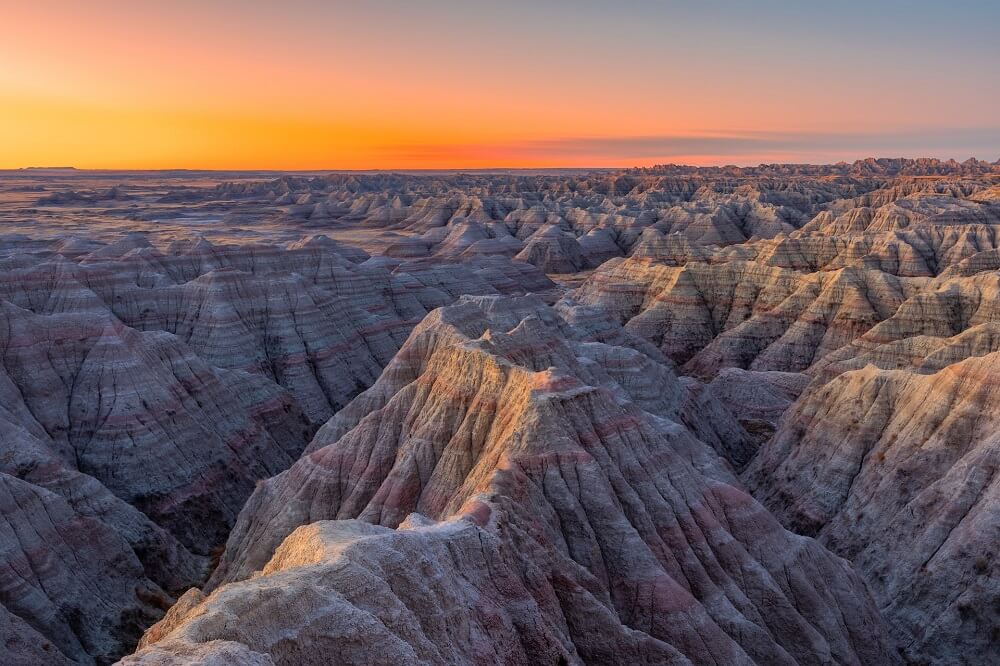
The White River Valley Overlook is one of the best overlooks in Badlands. This viewpoint allows you to see the different layers in the rocks close up. Stroll atop the cliffs and peer down into the valley of endless striped mounds and hills.
Things To Do Indoors In Badlands National Park
Visit Ben Reifel Visitor Center
The Ben Reifel Visitor Center is the main visitor center in the North Unit of Badlands National Park and is located near the southeast entrance. Inside the Visitor Center are several interesting exhibits that cover the geologic history of the area and information about prehistoric mammals and reptiles associated with the park.
You can also learn a little bit about the Lakota people who live south of the park on the Pine Ridge Indian Reservation which includes the communities of Kyle, Oglala, Manderson, Porcupine, Wanblee and Long Valley.
The Visitor Center is open every day of the week from 9am to 5pm in spring and summer, and 9am to 4pm during the winter (November – March). Of course there is a gift shop onsite to purchase a souvenir of your visit to Badlands as well as a decent book store.
Visit The Fossil Preparation Lab
For paleontologist wannabes or those of you who are interested in natural history, don’t miss visiting the Fossil Preparation Lab which is located inside the Ben Reifel Visitor Center.
Badlands is home to millions of years of fossil history which has been recorded in the park’s rock formations so there is a lot to learn here! To begin with, did you know that once upon a time the North American continent was cut into two halves by a sea known as the Western Interior Seaway?
Yes, it’s true. Badlands and South Dakota was underwater millions of years ago. This explains why there have been no dinosaur bones found in this part of North America (because they can’t swim). However, there is no shortage of marine fossils!
One impressive marine creature that lived in the sea that covered Badlands during the Cretaceous period was the Mosasaur. The Mosasaur was huge, as in the length of a bus! They looked a little bit like a monitor lizard but with an alligator-like tail and with turtle-like flippers. Countless fossils of the Mosasaur have been found all over South Dakota including in Badlands National Park. Fossils of the Mosasaur have been found in the Pierre Shale which are the oldest rocks in the park.
But Mosasaurs aren’t the only prehistoric creatures that roamed (or rather swam) in these lands, there are many other cool animal fossils that have been found here.
Park rangers in the Fossil Lab are able to answer any questions you may have about some of the prehistoric fossils found in the park, or you can just watch the paleontologists remove rocks from specimens to reveal fossils. This place is truly fascinating!
Fun Fact: The area now included in Badlands National Park is considered to be the birthplace of vertebrate paleontology in the American West. By the mid-1800s, 84 distinct species of animals had been identified in the North American fossil record, 77 of which were found in the White River Badlands!
Rent A Cabin At Cedar Pass Lodge
If you’re planning on spending a few days in Badlands National Park, consider booking a stay at the park’s only lodge – Cedar Pass Lodge.
The lodge isn’t really a hotel, but rather a collection of individual cabins. These cabins were designed to resemble the original cabins built here in 1928 and are super cute and cozy. All of the cabins are lined with pine from the Black Hills and the furniture is crafted from lodgepole pine.
Located near the southeast park entrance, these cabins make a good base for exploring this section of the park. You’ll be within walking distance of the visitor center, restaurant, and many of the popular hiking trails like the Door Trail, Window Trail, and Cliff Shelf Nature Trail.
Outside of the cabins are two outdoor chairs that you can kick back in at the end of a fun day of exploring. Relax and soak in South Dakota’s sweeping plains and vast skies.
Eat An Indian Taco At Cedar Pass Restaurant
The Cedar Pass Lodge which is open for breakfast, lunch, and dinner has a somewhat limited menu. However they do offer something a little unique on the menu which they call their ‘famous’ Indian Tacos.
These famous tacos are made with fry bread that is baked fresh every day here in the restaurant. The bread is then topped with buffalo meat, refried beans, cheese, olives, lettuce, and sour cream.
Fry bread is the official bread of South Dakota and a Native American food staple. Navajo frybread originated 144 years ago when the United States forced Indians living in Arizona to make a 300 mile journey known as the “Long Walk” and relocate to New Mexico where the land couldn’t easily support their traditional staples of vegetables and beans. To prevent the indigenous populations from starving, the government gave them canned goods as well as white flour, processed sugar, and lard—the makings of frybread.
While it appears that fry bread is nothing more than just fried dough, it is revered by some as a symbol of Native pride and unity. You can read a little more about fry bread history here.
If you’ve never tried fry bread before, this is a great place try it out!
Things To Do Near Badlands National Park
Get Your Photo Taken With An 80-Foot Dinosaur
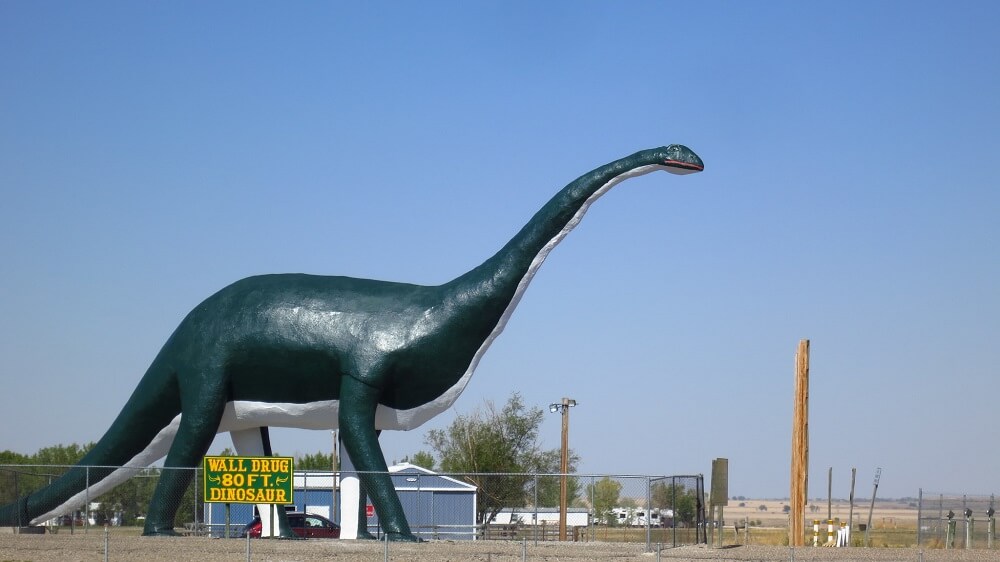
If you love quirky roadside attractions, you’ll love Wall Drug’s dinosaur mascot! The brightly painted, fifty ton, and eighty-foot long, concrete dinosaur lures motorists from the Interstate with the opportunity for a fun photo.
This Wall Drug icon was constructed by Emmet Sullivan who built other roadside attractions in America like nearby Rapid City’s Dinosaur Park and Arkansas’s Christ of the Ozarks. The towering Brontosaurus which was built in 1967, marks the exit for the mega tourist trap Wall Drug Store.
It is located on a paved road behind the Conoco gas station right off Interstate 90 in Wall. To find the dinosaur, from I-90 take exit 110 and turn north onto Glenn Street, then take the first right and drive past the gas station until you see the dinosaur.
Once you’re done taking silly pictures, follow the signs to Wall Drug which is only a few blocks away.
Explore Wall Drugstore

The drug store is a series of buildings with colorful wooden facades created to look a bit like the Wild West. We stopped into the drug store for breakfast on our second day and had a look around the many shops. Truthfully, it is a tacky place, but still an amusing destination to wander around for an hour or two.
Visit The National Grasslands Visitor Center

Besides managing national forests, the U.S. Forest Service also manages twenty national grasslands and one national tallgrass prairie. Seventeen of these grasslands are located on the Great Plains from North Dakota and Wyoming to Texas and New Mexico. The other three grasslands are located in California, Oregon, and Idaho while the tallgrass prairie is in Illinois.
The National Grasslands Visitor Center in Wall is the only visitor center for all of the grasslands mentioned above, so if you enjoy learning about ecology, be sure to stop by while you’re in the area visiting Badlands National Park.
Inside the visitor center are displays of grassland plants and wildlife, information on grazing management, an information desk, and a theater showing a twenty-five minute film about grasslands.
Rangers are available to answer any questions you may have not only about the importance of restoring native grasslands but also on nearby recreation opportunities, hiking, and other parks.
The National Grasslands Visitor Center is located at 708 Main Street in Wall, South Dakota, which is two blocks south of the world-famous Wall Drug Store.
D11 Minuteman Missile Silo

The Minuteman Missile National Historic Site which was established in 1999, illustrates the history and significance of the Cold War, the arms race and intercontinental ballistic missile development.
There are three facilities you can visit; a visitor center, a launch control center, and a missile silo/launch facility. These facilities represent the only remaining intact components of a nuclear missile field that once consisted of 150 Minuteman II missiles and 15 launch-control centers.
At these historic sites you can view the last intact Minuteman II ICBM system in the United States in a disarmed and demilitarized status. Guided tours are available of the underground Launch Control Center and a missile silo can be observed from above.
The Visitor Center is located just off Interstate-90 along Cottonwood Road (Highway 240) near Badlands National Park.
Go Horse Riding At Hurley Butte Ranch
For a unique way to experience Badlands National Park, organize a guided horseback ride with Hurley Butte Ranch. The rides are a lot of fun and will make your trip unforgettable.
This local family has a real working ranch and are located not too far from the park’s southeast entrance. After arriving, the owners will give you instructions (if you’ve never ridden a horse before) and let you ride around the corral until you feel comfortable.
Once you feel comfortable riding on their property, they’ll take you out to the wide open prairie lands around the beautiful Badlands where you are allowed to ride to the best of your ability.
The Hurley family would prefer it if you could schedule your ride in advance, even if it’s only a day or two’s notice. Guided rides can accommodate 1-5 riders. To make a booking, give them a phone call on 605-450-1683 or check out their website to learn more about them.
Where To Stay In Badlands National Park
The only accommodations inside Badlands National Park is at Cedar Pass Lodge which is actually a collection of cabins. The cabins are very nice and were designed to resemble the original cabins built here in 1928. All of the cabins are lined with pine from the Black Hills and the furniture is crafted from lodgepole pine by a family owned business in Montana. These cabins come at a nightly rate of $189 plus tax. Note that pets are not allowed inside cabins. Cedar Pass Lodge is open late April through late October.
RECOMMENDED HOTELS NEAR BADLANDS
Hotels are limited near Badlands National Park and room demand is high between May and September. The two best places to stay outside of the park are Wall and Interior, both of which are a few short miles from the park’s entrances. Here are the best hotels near Badlands.
Best Western Plains Motel is walking distance to the touristy Wall Drug Store and only a short drive to the Pinnacles Entrance of Badlands National Park. This affordable hotel features clean rooms, free breakfast, and an indoor and outdoor swimming pool.
Badlands Frontier Cabins is located in Wall and only a short ten minute drive to the Pinnacles Entrance of Badlands. These log cabins are cute, cozy, and feature kitchenettes and western style furnishings.
Badlands Motel and Campground offers basic no frills rooms and a campground that accommodates both RVs and tents. The best thing about this place is how close it is to the park’s southeast entrance. Views are spectacular and you can expect to hear coyotes, frogs and other critters during the night. Camping here is a very cool experience! Fun fact: parts of the film Nomadland were filmed here.
KOA Badlands Campground is located near Badlands National Park’s southeast entrance in Interior. Campsites are very nice and shaded by mature trees. Wifi is available and kids will enjoy the miniature golf and swimming pool. Like all KOAs, this campground offers a free pancake breakfast and also has an onsite restaurant serving an early dinner.
CAMPING IN BADLANDS NATIONAL PARK
There are two campgrounds inside Badlands National Park; Cedar Pass Campground and Sage Creek Campground. Backcountry camping is also allowed and unlike other national parks, you don’t need to obtain a permit.
Cedar Pass Campground has 96 campsites and offers both tent and RV sites with electric hookups. Each campsite has a picnic table with a shaded awning. There is an onsite coin-operated shower available for use.
The campground is open from early April through mid-October. Campsites are $23 per night for tent camping and $38 per night for RV sites. Reservations for the Cedar Pass Campground can be made through contacting the Cedar Pass Lodge online or by phone at 877-386-4383.
Sage Creek Campground is a free campground with 22 sites available for both tents and RVs however motor homes, trailers, and other recreational vehicles greater than 18 feet in length are prohibited.
Backcountry Camping is allowed in Badlands National Park and unlike other parks, you don’t need to obtain a permit here. As long as you set up camp at least a half mile away from a road or trail and aren’t visible to others, you are good to go. Park at a trailhead or overlook and be sure to leave a note on the dash stating when you will be returning. Remember to always pack out your trash! For more information on regulations and where to backcountry camp, click here.
Use the interactive map above to search for hotels and vacation homes near Badlands National Park. Recommended hotels, campgrounds, and other points of interest have also been marked on the map.
Read More On Badlands National Park
- How To Hike The Notch Trail At Sunset
- Badlands National Park Travel Guide
- Hiking Cliff Shelf Nature Trail In Badlands National Park
- 10 Best Hikes In Badlands National Park
Pin For Later!
Have you got any questions about visiting Badlands National Park? Do you have any advice to share? Let us know in the comment section below!
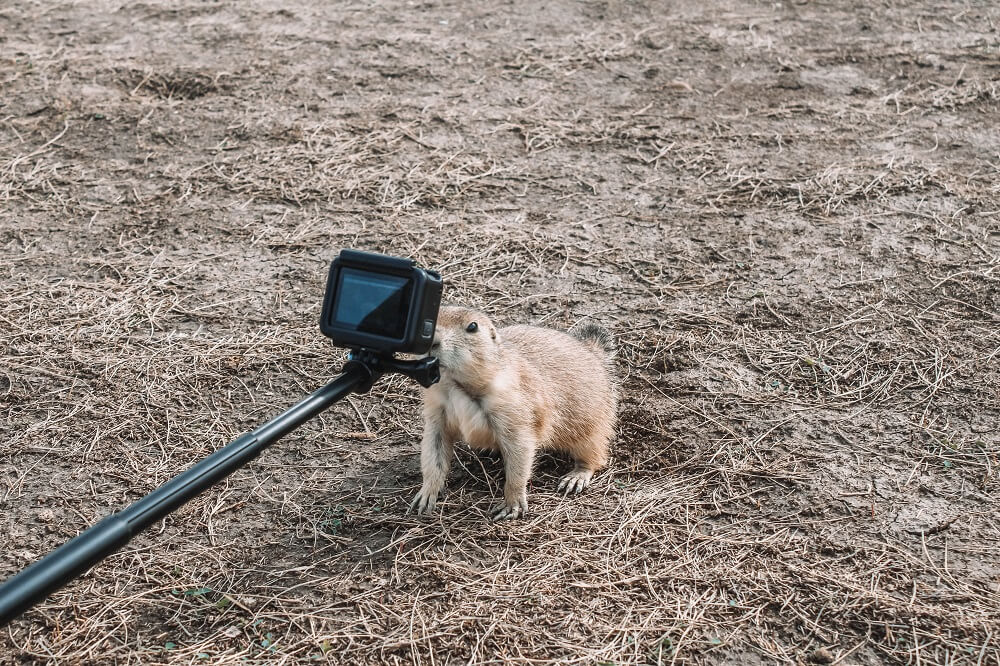





I vaguely remember visiting the Badlands with my family as a kid. It’s been on my mind over the past few years to get back there. This is a good guide. Thanks.